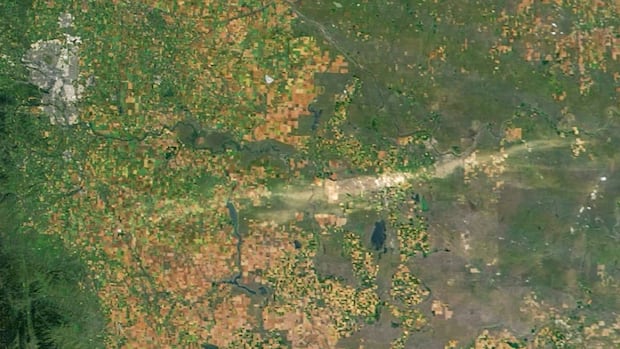Hail, wind left 200-km ‘scar’ across Alberta that’s visible from space

The recent wind and hailstorm that ravaged southern Alberta last month has left a lasting impact on the prairie landscape. The storm, which brought 150-kilometre-per-hour gusts, tore through crops and grasslands, leaving behind a visible “scar” that can even be seen from outer space.
The most intense part of the storm, stretching from south of Calgary to Saskatchewan, created a “hail scar” that measures about 15 kilometres wide and 200 kilometres long. This swath of destruction starts near Vulcan and extends north of Brooks, where the damage was particularly severe. Home siding was demolished, corn stalks were torn in half, and irrigation pivots were overturned.
Researchers from the Northern Hail Project at Western University studied the aftermath of the storm and described the damage as “among the worst the NHP has documented to date.” Entire fields of crops were leveled, and even grasslands were pulverized, with native shrubs stripped bare.
Cleanup efforts are currently underway, with volunteers helping to clear debris and fallen trees from affected areas. Farmers and ranchers are assessing the damage and working to salvage what they can from their fields and pastures. For many, the losses are devastating, with years of reduced grazing capacity and crop yields expected.
As the affected communities work to recover from the storm, experts warn that the healing process will take time. Crops and vegetation may fill in the hail scar relatively quickly, but careful management is needed to ensure proper regrowth. Cattle producers will need to monitor their pastures and implement strategies to encourage recovery, as the loss of natural mulch can have long-lasting effects on soil health and moisture retention.
Overall, the impact of this powerful storm serves as a reminder of the resilience of the prairie landscape and the importance of proactive land management practices in the face of natural disasters. With time and careful stewardship, the affected areas will begin to heal and restore their natural beauty once again.



